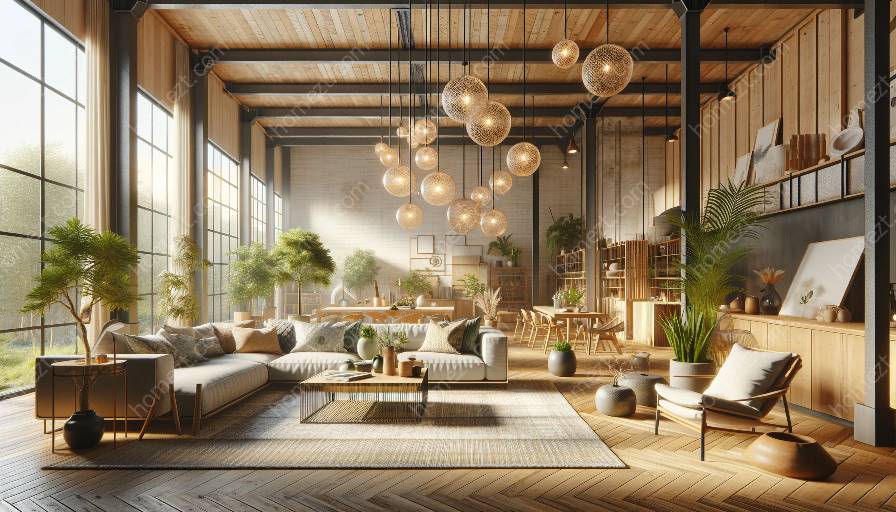Interior design and styling play a significant role in creating inviting and functional spaces. However, the materials and processes involved in traditional interior design can have adverse effects on the environment. This has led to a growing emphasis on sustainable and eco-friendly design practices in the industry. Exploring the ethical implications of sustainable design in interior spaces can shed light on the environmental and social impacts of these practices.
The Importance of Sustainable and Eco-Friendly Design
Sustainable and eco-friendly design in the context of interior spaces refers to the use of materials, processes, and design principles that minimize environmental impact, promote energy efficiency, and support social responsibility. Embracing sustainable design practices is crucial for reducing the carbon footprint of interior design projects and safeguarding the well-being of both current and future generations.
By considering ethical implications, interior designers and stylists can contribute to a more sustainable and socially responsible built environment. This involves evaluating the life cycle of materials, sourcing eco-friendly and renewable resources, and implementing energy-efficient solutions.
Environmental and Social Ethical Considerations
When applying sustainable design principles in interior spaces, several ethical considerations come into play. Firstly, the selection of materials and finishes should prioritize those with minimal environmental impact. This includes utilizing recycled, upcycled, or locally sourced materials to reduce carbon emissions associated with transportation.
Furthermore, interior design and styling should prioritize the well-being of occupants by creating healthy indoor environments that are free from harmful chemicals and pollutants. Ethical considerations also extend to the ethical treatment of workers and artisans involved in the production of design elements and furnishings, advocating for fair labor practices and supporting local craftsmanship.
Integration of Sustainable Practices
The integration of sustainable design practices in interior spaces involves a holistic approach that encompasses various aspects of design and construction. This includes the selection of energy-efficient appliances, lighting, and HVAC systems to improve the overall energy performance of the space. Additionally, designers can incorporate passive design strategies such as natural daylighting and ventilation to reduce the dependency on artificial energy sources.
Moreover, sustainable interior design focuses on longevity and adaptability, aiming to create spaces that can evolve with changing needs and trends, thereby reducing the impact of constant renovations and remodeling. Sustainable practices also encompass the efficient use of resources, waste reduction, and the incorporation of green technologies, such as smart home systems and renewable energy solutions.
Educating and Advocating for Sustainable Design
One of the ethical responsibilities of interior designers and stylists is to educate clients and the wider community about the benefits and importance of sustainable design. By advocating for environmentally conscious choices and promoting the adoption of sustainable practices, professionals in the industry can drive positive change and inspire a shift towards more responsible design solutions.
Engaging in ongoing education and staying informed about advancements in sustainable materials and technologies is essential for designers to make informed ethical decisions. Additionally, collaborating with manufacturers and suppliers committed to ethical and sustainable production practices can help promote transparency and accountability throughout the supply chain.
Challenges and Opportunities
While the adoption of sustainable design practices presents numerous benefits, it also comes with challenges. Designers and stylists may face constraints related to cost, availability of sustainable materials, and the need for specialized knowledge in green building principles. Overcoming these challenges requires a proactive approach, creativity, and a commitment to seeking innovative solutions.
Nevertheless, embracing sustainable design presents exciting opportunities for creativity and innovation. It encourages the exploration of alternative materials, spatial configurations, and design strategies that align with eco-friendly and ethical principles. This fosters a culture of responsible design that considers the long-term impact of interior spaces on both the environment and human well-being.
Conclusion
Evaluating the ethical implications of sustainable design in interior spaces is essential for shaping a future where design practices prioritize environmental sustainability, social responsibility, and ethical considerations. By integrating eco-friendly and sustainable design principles, interior designers and stylists can contribute to the creation of healthier, more resilient, and aesthetically pleasing spaces while minimizing negative impacts on the planet and its inhabitants.


























